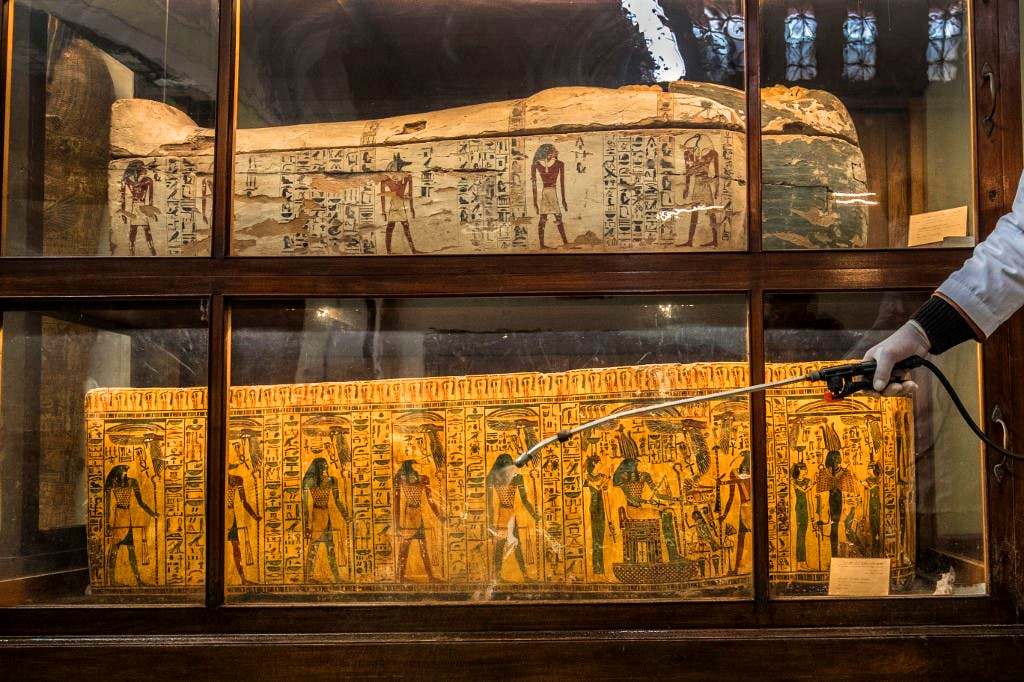The COVID-19 Crisis and Museums in Egypt (Shreen Amin, Egypt, ITP 2016)
Written by Shreen Amin, Director of the Children’s Museum, Egyptian Museum, Cairo (Egypt, ITP Fellow 2016)
The Egyptian Museum
The measures taken during the COVID-19 crisis in the Museums in Egypt play an important role in enhancing community engagement and overcoming social isolation. With its rich cultural and educative contents and societal functions, several initiatives undertaken in response to COVID-19 are applied in the Museums of the Egyptian Ministry of Tourism and Antiquities (MoTA). The risk preventive measures for the safety and security of the museums, their staff, and visitors are one of the main approaches. In addition, the development of a variety of digital tools including virtual tours, social media, live streaming, online exhibitions, and online video. The guidelines also include the installation of floor signs for social distancing and daily temperature checks for visitors and staff.


The Egyptian Museum had been closed since March 2020 because of the COVID-19 pandemic. Then, we started to receive visitors on July 1 2020 under strict anti-coronavirus measures; the reopening of the Egyptian Museum in Tahrir comes after the precautionary measures approved by the Ministry of Tourism and Antiquities. In order for visitors to enter the Egyptian Museum, they must wear a face-mask and apply social distancing. For this reason, signs have been placed inside the museum to maintain social-distancing and only 50 percent of the total capacity was allowed entry at once to prevent crowding.

The Egyptian Museum during the period of closure
A preventive measure to curb the spread of coronavirus had been taken; sterilization and high-level disinfection procedures of the Egyptian museum following the guidelines of the Egyptian Ministry of Health & and the Egyptian Ministry of Tourism and Antiquities. Using special materials designed to clean and protect the artefacts in restoration labs, where the artefacts were kept behind locked glass showcases as staff proceeded with the disinfection procedures.



The Egyptian Museum during the period of closure was active via all the social media platforms when the visitors can’t visit the museum. The Egyptian Museum was bringing the museum to their homes via exploring the museum collection, presenting online lectures, and online activities for children. Egypt’s Ministry of Tourism and Antiquities offers virtual tours to Egyptian museums via its websites and social networking platforms. The tours are organized in cooperation with its partners from scientific and archaeological institutes. The virtual and video-guided tours are offered in the English language with Arabic subtitles presented by tour guides Fatma Abdala and Walid Al-Batouty. More details can be found in the links below.
https://www.sis.gov.eg/Story/145863?lang=en-us
https://www.facebook.com/EgyptianMuseumCairo
https://twitter.com/EgyptianMuseumC
UNESCO identifies the Egyptian Museum in Tahrir as one of the most influential museums in Africa because the its official Twitter account is ranked second as the most influential Twitter account for an African museum. This selection occurred in the annual initiative of Museum Week under the auspices of UNESCO. Museum Week is an international festival organised by cultural institutions on social media. The main theme of this fifth edition of #MuseumWeek was “life in society”. The fifth edition which was held from April 23 to 29 2020 and focused on the values of tolerance and citizenship. The event aims to support the digital environment, which is often controlled by intolerance, with the cultural, artistic, technical, and scientific content promoted by museums. The principle of the event is simple: around the formula “7 days, 7 themes, 7 hashtags”, museums, galleries, archive centres, libraries and other cultural institutions around the world, celebrate culture, art and science with their public on social networks.

The Egyptian Museum after the period of closure
On July 1, 2020 the Egyptian museum was reopened under strict anti-coronavirus measures. The workshops; events; education programs, and curatorial works are applied under these measures. Body temperature scanners and hand sanitizers are at the entrance, while face masks and social distancing are mandatory inside. In order to comply with the anti-COVID measures, visitors in the Egyptian Museum have to follow the authorized path supported by floor signs. Similar provisions were put in all the galleries of the museum and around the showcases.


The photos of the COVID-19 crisis measures in museums are an historic phenomenon worth documenting for public display. Content related to COVID-19 procedures need to be captured and catalogued. Documentation is needed to define how museums and cultural institutions are seeing, feeling, and coping with this pandemic.
Museum staff should be asked to record their thoughts and experiences by writing them down, taking pictures, recording videos, or doing anything else to express what they are doing and feeling at this particular moment in history.




